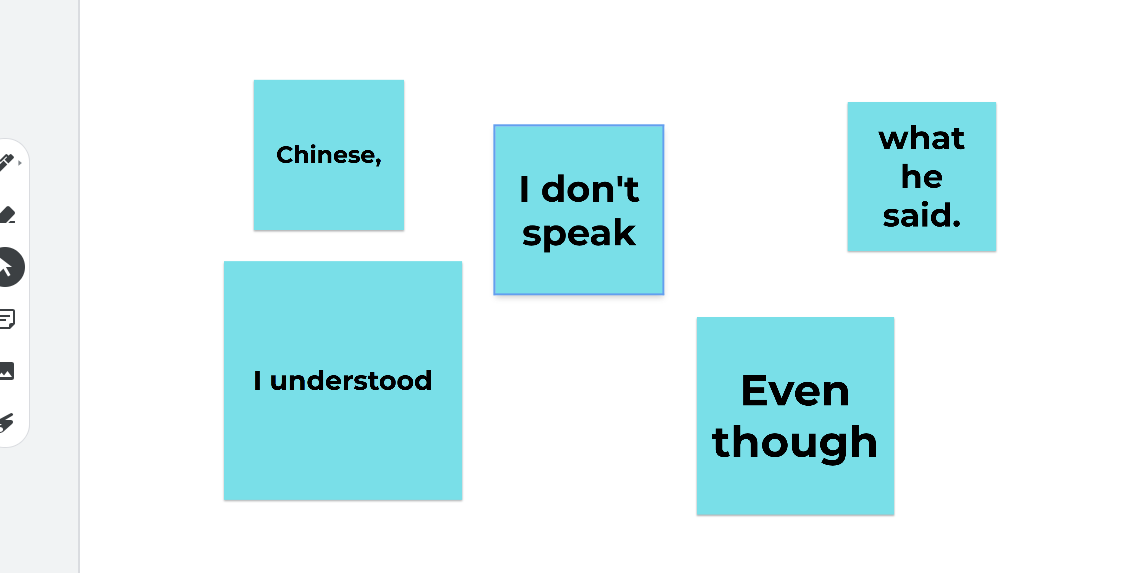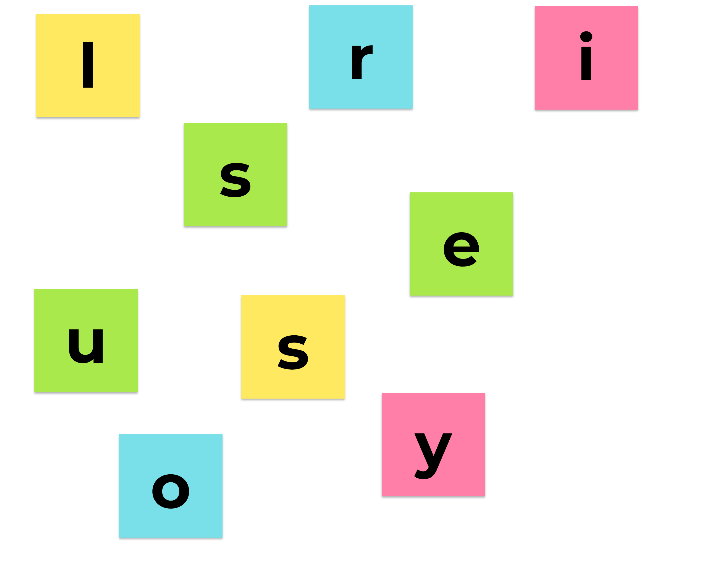One thing I miss about face-to-face teaching is my whiteboard. I miss writing on it, drawing, watching my students play whiteboard games or draw funny pictures!
Whiteboards are a great learning tool not just for students, but teachers as well. Taking photos of my daily whiteboards really helped me reflect on my teaching when doing Delta Module 2. The bigger the whiteboard, the happier I was!
Most platforms now come with a whiteboard but it’s not always interactive, so teachers often say: “the lesson is too teacher-centred”. Interactive whiteboards can make a big difference.
Google jamboard is one of my favourite tools. It’s free – you can use the web version or download the app on your mobile device. You can add sticky notes, write, draw, add pictures or stickers as well as attach any material shared on google drive.
If you don’t know how to use it, here’s an easy tutorial.
I use my regular whiteboard when I want to make notes, and jamboard when I want students to get active. Here are some easy activities that are quite popular with my students!
1. Brainstorming.
This one is particularly useful before writing a pros and cons essay or preparing for a discussion. Students brainstorm and share ideas by adding sticky notes. You can ask them to use different colours for pros and cons or each student uses a different colour etc. Why? It just looks so much nicer when the board is colourful! Jamboard really brought brainstorming to life.
In the example below, my two advanced students shared their thoughts on lifting the lockdown back in April.

2.Predicting/remembering content
Before reading a text/listening to a recording, you can use it to ask learners to make predictions about the content.
If they’ve already read a text in a previous lesson and you need to create a link with the next lesson, ask them to write what they remember about the text. In the example below, my B2 students wrote what they remembered about the what they had read in our previous class:

3. Unjumble the sentence
Students order the sticky notes to make sentences. They notice linkers, punctuation and improve their syntax skills. You can write one word per box or more, depending on how complex you want the task to be.
For teenagers/adults: Share the link with them and give permission to edit. Share your screen so they can see which “page/slide” you’re on. Ask one student at a time to move the boxes in order to create a correct sentence.

For younger learners who are not tech-savvy, just move the sticky notes for them. They say, the word, you move the boxes.
In the activity below, my second-graders read the answers (on the right) and put the words in the right order to make the questions (on the left).

4. Sentence maker
Create two identical jamboards. Put students in two groups and give each group the link to one of the boards. Tell them to create ( a number of ) sentences using the words given. Set a timer to make it competitive! Then project the jam boards and compare results. This task helps practice lexical collocations such as verb-noun combinations or colligations, e.g. verb+preposition. You can write full stops to signal end of sentence, or not, to make it more difficult. Either way, it’s a nice, not-so demanding warmer to start the lesson.

5. Pictionary
One thing I love is that you can create your jamboards whenever you’re inspired, save them and share them with your students when you have class. If you’re using a tablet with a stylus pen, it’s so easy to draw funny images. Then, just share your screen and ask learners to make sentences. If they’re feeling creative, they can take turns to draw and their peers can shout out sentences. See example below:
6. What’s the word?
Select some words you want to review. Create anagrams or scatter the letters around like in the picture below and ask your learners to find the word. Use one word per slide. If you share the link, your students will be able to move the sticky notes using the arrow. They really like that! Why not ask them to create their own anagrams if you have an extra 5 minutes?
This visual representation of “building the word piece by piece” helps most learners memorise the written form and it’s way more engaging than asking them to spell or write it.

More ideas..
This is a fantastic blog post! Kris Szajner shares 10 free Jamboard templates for online classes.
Play bingo online. Read Cristina Cabal’s how-to post here .


Great ideas, Rachel! Thanks for sharing. Never heard of this platform!
LikeLiked by 1 person
Excellent, Rachel. I’ve only recently found your blog and it’s gold! Congrats on the amazing work. I also watched you with Cecilia Nobre, Lachesis, and Cris. Great live on Online Teaching. I’m definitely following now
LikeLiked by 1 person
Thank you for your positive feedback, André! I’ll try my best to keep it interesting! Glad you liked the live 🙂
LikeLiked by 1 person
Hi Rachel. Thanks for sharing. I attended an ESP webinar recently and I saw another creative way of using the Jamboard. It can be used as a need analysis too! when teaching a group class. Students type on different jamboard slides. One might have the heading” What I hope to learn during this course ” Another might be ‘One thing I find hard to do in English is ….’ and the last one could be ‘ I am learning English because in the future I plan to ….’ The teacher can get a visual representation of the learners’ needs before the course and remove the sticky notes gradually throughout the course as they are covered. That way the students feel that their needs are being met.
LikeLiked by 1 person
Sounds great!
LikeLike
Hi Rachel! I love using google jamboard in my classes. Actually that’s the tool I used the most. I started to use it when I was doing Delta Module 2 and it went pretty well. You can also use it for your first class (getting to know each other) or for a warm up. Here’s the link of two activities I’ve tried in class –>
https://jamboard.google.com/d/1netTHcc18MDHB3g19bBMjVmne7yvPTedvzowryv0No4/viewer?f=0
In the first slide you’ve got some numbers, students choose one, delete it and answer the question (you can see the questions in slide 2) then you’ve got a tic tac toe game you can use for teaching comparative for example.
https://jamboard.google.com/d/18UlBpOA1TqmJEHoQ7Xv4DnsaEwDnmw0FyM6MwyerwUk/viewer?f=0
This is a warm up activity I’ve used not only with teens or children but also with adults and they really loved it! You can do it as a whole class or in groups. Again, they have to choose a number and bring the object, the first one to get it gets a point!
LikeLiked by 1 person
Awesome, thank you for sharing the links! 😀
LikeLike